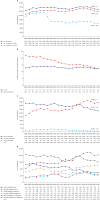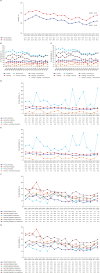Trends in Incidences, Treatments and Outcomes of Spontaneous Subarachnoid Hemorrhage in Korea Between 2002 and 2022
- PMID: 40726239
- PMCID: PMC12303661
- DOI: 10.3346/jkms.2025.40.e171
Trends in Incidences, Treatments and Outcomes of Spontaneous Subarachnoid Hemorrhage in Korea Between 2002 and 2022
Abstract
Background: Access to equitable care for severely emergent diseases serves as a key indicator for evaluating the performance of a country's health care system. The aim of this study was to examine trends in the incidence, treatment and outcomes of patients with spontaneous subarachnoid hemorrhage (SAH) using Korean national claims data.
Methods: A retrospective analysis was conducted on a cohort of inpatients with spontaneous SAH from 2002 to 2022, utilizing data from the Korean National Health Insurance Service. The primary outcomes assessed were fatalities within 30 and 90 days from the index date of hospitalization.
Results: While the crude incidence rate has remained constant, the age-standardized incidence rate (ASR) has decreased from 22.0 per 100,000 in 2002 to 12.5 per 100,000 in 2022. The regions with the highest incidence rates were Gyeonggi (29,833 cases, 21.0%) and Seoul (26,484, 18.7%). In 2002, 59.6% of all patients received major treatments within 48 hours of admission, with a distribution of 68.4% in tertiary hospitals and 30.7% in secondary hospitals. By 2022, the proportion of patients receiving major treatment had increased to 71.9%, with 42.3% in tertiary hospitals and 57.5% in secondary hospitals. Endovascular coiling surpassed surgical clipping as the predominant treatment modality between 2013 and 2014. On average, 70.1% of treated patients received care within their area of residence, with the highest rates in Daegu (92.9%), Gwangju (91.4%) and Busan (90.1%) and the lowest in Jeonnam (14.2%). From 2002 to 2019, the 30-day and 90-day fatality rates declined from 21.2% to 19.2% and from 24.4% to 21.3%, respectively, whereas these rates gradually increased after 2020.
Conclusion: The total number of patients with spontaneous SAH remained relatively constant, whereas both the ASR and overall crude fatality rate declined. A national shift in treatment modalities was observed, with coiling surpassing clipping and admissions to secondary hospitals exceeding those to tertiary hospitals. Regional disparities in health care utilization were identified, highlighting the need for a locally accountable health care system in health care policy.
Keywords: Hemorrhagic Stroke; Korea; SAH Fatality; SAH Incidence; SAH Treatment; Spontaneous Subarachnoid Hemorrhage (SAH).
© 2025 The Korean Academy of Medical Sciences.
Conflict of interest statement
The authors have no potential conflicts of interest to disclose.
Figures





Similar articles
-
[Volume and health outcomes: evidence from systematic reviews and from evaluation of Italian hospital data].Epidemiol Prev. 2013 Mar-Jun;37(2-3 Suppl 2):1-100. Epidemiol Prev. 2013. PMID: 23851286 Italian.
-
Do Patients of Different Levels of Affluence Receive Different Care for Pediatric Osteosarcomas? One Institution's Experience.Clin Orthop Relat Res. 2025 Apr 1;483(4):748-758. doi: 10.1097/CORR.0000000000003299. Epub 2024 Oct 30. Clin Orthop Relat Res. 2025. PMID: 39485923
-
Comparison of Two Modern Survival Prediction Tools, SORG-MLA and METSSS, in Patients With Symptomatic Long-bone Metastases Who Underwent Local Treatment With Surgery Followed by Radiotherapy and With Radiotherapy Alone.Clin Orthop Relat Res. 2024 Dec 1;482(12):2193-2208. doi: 10.1097/CORR.0000000000003185. Epub 2024 Jul 23. Clin Orthop Relat Res. 2024. PMID: 39051924
-
Trends in incidence and treatments of spontaneous subarachnoid hemorrhage- a 10 year hospital based study.Acta Neurochir (Wien). 2024 Apr 22;166(1):188. doi: 10.1007/s00701-024-06069-z. Acta Neurochir (Wien). 2024. PMID: 38649538 Free PMC article.
-
Intravenous magnesium sulphate and sotalol for prevention of atrial fibrillation after coronary artery bypass surgery: a systematic review and economic evaluation.Health Technol Assess. 2008 Jun;12(28):iii-iv, ix-95. doi: 10.3310/hta12280. Health Technol Assess. 2008. PMID: 18547499
References
-
- Lawton MT, Vates GE. Subarachnoid hemorrhage. N Engl J Med. 2017;377(3):257–266. - PubMed
-
- Nieuwkamp DJ, Setz LE, Algra A, Linn FH, de Rooij NK, Rinkel GJ. Changes in case fatality of aneurysmal subarachnoid haemorrhage over time, according to age, sex, and region: a meta-analysis. Lancet Neurol. 2009;8(7):635–642. - PubMed
-
- Kwon JW, Lee HJ, Hyun MK, Choi JE, Kim JH, Lee NR, et al. Trends in the incidence of subarachnoid hemorrhage in South Korea from 2006-2009: an ecological study. World Neurosurg. 2013;79(3-4):499–503. - PubMed
MeSH terms
Grants and funding
LinkOut - more resources
Full Text Sources

